Common Anatomy Terms
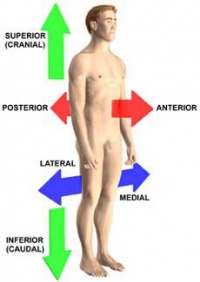
Directional Terms:
Anterior (ventral) - Toward the front of the body
Central - At or near the center of the body or organ
Distal - Part of an extremity that is farther from the point of attachment to the trunk
External (superficial) - Toward or on the surface of the body
Inferior (caudad) - Away from the head
Internal - Away from the surface of the body
Lateral - Away from the midline of the body
Medial - Toward the midline of the body
Parietal - Pertaining to the outer boundry of body cavities
Peripheral - Exernal to or away from the center of the body or organ
Posterior (dorsal) - Toward the back of the body
Proximal - Part of an extremity that is closer to the point of attachment to the trunk
Superior (cephalad) - Toward the head
Visceral - Pertaining to the internal organs
Learning Human Anatomy

It's not easy to learn human anatomy. We've located a home study course that's custom made to help you learn anatomy by using visual material that's really helpful.
With over 3,000 pages (wow) of physiology and anatomy materials, this guide has proven to be a great aide for anatomy students to help them learn this material and pass their exams. It contains:
- Full Diagrams
- Guidebooks
- Certification
- Lessons
- Quiz & Answers
- & More...
Planes:
 Frontal Plane
Frontal Plane - (AKA: Coronal Plane) Is an imaginary line that runs vertically across the shoulders, sides, and hips to divide the body from front to back
Midsagittal Plane - (AKA: Sagittal Plane or Lateral Plane) Is an imaginary line that runs vertically down the spine, face, and center of the abdomen to divide the body into left and
right portions.
Transverse Plane - (AKA:Cross-Sectional Plane) imaginary line that runs horizontally through the abdomen (at the naval) and through the back to divide the body into top and bottom.
Body Cavities:
Abdominopelvic Cavity - A subdivision of the ventral cavity which encases the abdominal cavity and pelvic cavity.
Dorsal Cavity - A body cavity which encases the cranial cavity and vertebral canal.
Thoracic Cavity - A subdivision of the ventral cavity which is located in the chest and encases the mediastinum, pleural cavity, and pericardial cavity
Ventral Cavity - A cavity that encases the thoracic cavity, the diaphragm, and the abdominopelvic cavity.
Abdominopelvic Quadrants:
Left Upper Quadrant (LUQ) - One of the four quadrants that the abdominopelvic area can be divided into. Located in the left upper portion of the abdomen it includes a view of the
stomach, spleen, the left kidney, and parts of the duodenum, pancreas, left ureter, small intestine, and transverse and decending colon.
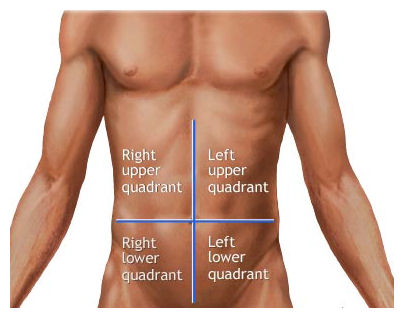 Left Lower Quadrant (LLQ) - One of the four quadrants that the abdominopelvic area can be divided into. Located in the left lower portion of the abdominopelvic area and provides
partial views of the small intestine, descending and sigmoid colon, rectum, left ureter, and urinary bladder.
Left Lower Quadrant (LLQ) - One of the four quadrants that the abdominopelvic area can be divided into. Located in the left lower portion of the abdominopelvic area and provides
partial views of the small intestine, descending and sigmoid colon, rectum, left ureter, and urinary bladder.
Right Lower Quadrant (RLQ) - One of the four quadrants that the abdominopelvic area can be divided into. Located in the right lower portion of the abdominopelvic area and includes a
view of the appendix, cecum, and partial views of the ascending colon, small intestine, right ureter, urinary bladder, and rectum.
Right Upper Quadrant (RUQ) - One of the four quadrants that the abdominopelvic area can be divided into. Located in the right upper portion of the abdomen it provides a view of the
gallbladder, most of the liver, and partial views of the pancreas, small intestine, and ascending and transverse colon.
Abdominopelvic Regions :
Epigastic Region - One of the six regions the abdominopelvic cavity can be divided into. It is located in the center of the upper abdomen just below the sternum. It icludes a partial
views of the liver, stomach, pancreas, duodenum, and transverse colon.
Hypogastric Region - One of the six regions the abdominopelvic cavity can be divided into. It is located the center of the lower pelvis between the hips. It includes a view of the
urinary bladder and rectum, and partial views of the ureters, small intestine, and sigmoid colon.
Left Hypochondriac Region - One of the six regions the abdominopelvic cavity can be divided into. It is located in the upper left abdomen and includes the floating rib cage. It
provides a view of the spleen, and partial views of the stomach, transverse colon, and left kidney.
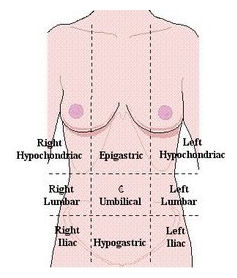 Left Iliac Region - One of the six regions the abdominopelvic cavity can be divided into. It is located in the left lower pelvic area and includes the left acetabulum. It provides
partial views of the small intestine, and descending and sigmoid colon.
Left Iliac Region - One of the six regions the abdominopelvic cavity can be divided into. It is located in the left lower pelvic area and includes the left acetabulum. It provides
partial views of the small intestine, and descending and sigmoid colon.
Left Lumbar Region - One of the six regions the abdominopelvic cavity can be divided into. It is located to the left of the naval and provides a view of the descending colon and
partial views of the left kidney and small intestine.
Right Hypochondriac Region - One of the six regions the abdominopelvic cavity can be divided into. It is located in the upper right abdomen and includes the floating rib cage. It
provides a view of the gallbladder, and partial views of the liver, transverse colon, and right kidney.
Right Iliac Region - One of the six regions the abdominopelvic cavity can be divided into. It is located in the right lower pelvic area and includes the right acetabulum. It provides
a view of the appendix and cecum and a partial of the small intestine.
Right Lumbar Region - One of the six regions the abdominopelvic cavity can be divided into. It is located to the right of the naval and provides a view of the acsending colon and
partial views of the small intestine and right kidney.
Umbilical Region - One of the six regions the abdominopelvic cavity can be divided into. It is located directly in the center of the abdominopelvic cavity and provides a partial view
of the duodenum, small intestine, kidneys, and ureters.
Regions of the Head and Neck :
Cephalic - The head. Contain smaller facial and cranial regions.
Cervical - The neck.
Cranial - The part of the head containing the brain.
Facial - The face.
Regions of the Trunk
Abdominal - The region located between the lowest ribs and the hip bones.
Abdominopelvic - Contains both the abdominal and pelvic regions.
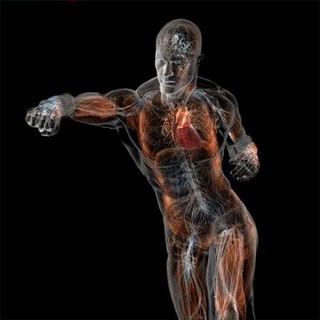 Axillary - The armpits
Axillary - The armpits
Coxal - The hips.
Dorsum - The posterior surface of the thorax.
Genital - The external reproductive organs.
Gluteal - The buttocks.
Inguinal - The groin.
Lumbar - The lower back.
Pectoral - The Chest.
Perineal - The small region between the anus and the external reproductive organs.
Pelvic - The region enclosed by the pelvic bones.
Sacral - The region over the sacrum and between the buttocks.
Sternal - The region over the breast bone.
Vertebral - The region over the back bone.
|

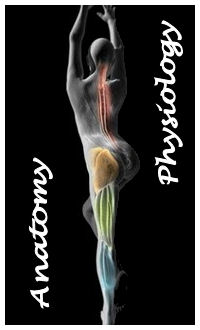



 Frontal Plane - (AKA: Coronal Plane) Is an imaginary line that runs vertically across the shoulders, sides, and hips to divide the body from front to back
Frontal Plane - (AKA: Coronal Plane) Is an imaginary line that runs vertically across the shoulders, sides, and hips to divide the body from front to back
 Left Lower Quadrant (LLQ) - One of the four quadrants that the abdominopelvic area can be divided into. Located in the left lower portion of the abdominopelvic area and provides
partial views of the small intestine, descending and sigmoid colon, rectum, left ureter, and urinary bladder.
Left Lower Quadrant (LLQ) - One of the four quadrants that the abdominopelvic area can be divided into. Located in the left lower portion of the abdominopelvic area and provides
partial views of the small intestine, descending and sigmoid colon, rectum, left ureter, and urinary bladder.
 Left Iliac Region - One of the six regions the abdominopelvic cavity can be divided into. It is located in the left lower pelvic area and includes the left acetabulum. It provides
partial views of the small intestine, and descending and sigmoid colon.
Left Iliac Region - One of the six regions the abdominopelvic cavity can be divided into. It is located in the left lower pelvic area and includes the left acetabulum. It provides
partial views of the small intestine, and descending and sigmoid colon.
 Axillary - The armpits
Axillary - The armpits
